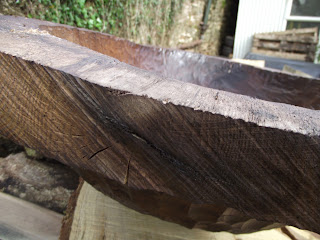In the pan for boiling, and after boiling.
I'll leave this for several months now, before coming back to finish the surface.
Time to rive down the oak tree that I brought back from the woods the other week.
This will become the drawer front to go in that hole there.
This is the bowl I started hollowing in the woods with the chainsaw and flat adze, otherwise I couldn't move it. It contains the heart of the main trunk running through both ends, so it might not work i.e. it may rip itself apart as it dries out. I am hoping giving it a long slow boil this will be prevented.
As you can see, I am also keeping it filled with water overnight, in between carving. It's a big one.
In fact, any bigger and I will need a bigger pan.
With about 80 litres of water and a small fire it took about 6 hours to come to the boil. I kept stoking it for an hour or two and then left it overnight. I imagine it kept bubbling for another hour or so.
With only minimal cracking on the end I am hopeful.
So onwards with the other half of this section of trunk.
I think this one might be called the dragonfly bowl.

















Hello R.J.
ReplyDeleteIs it the oak causing this anxiety? Is it a wood particularly prone to splits in such an instance? Out here I got me a big stem; a trough is one option but maybe oak is not suitable. What do you think? It is quite a nice stem.
Yes, oak has a tendency to split as it dries, especially when it is in big chunks. English oak more so than American varieties I believe. I don't have much experience with red oak or white oak. I tend to only use logs for bowls which are no good for riving for furniture. If you have a good, straight log best to split it and make some joined furniture. Maybe find another log for your trough.
ReplyDeleteMine must certainly be Dutch oak. Lets just call it Quercus Robur a wood that can give its share of grief and leave it at that. Splitting is one of the options I had in mind though I'm partial to hewing beams too. At two meters long do you have any tips for successful splitting?
ReplyDeleteHi Ernest. Didn't realise that was you when I replied above. Both quercus robur and petraea (as you probably know) don't split as well as red and white oak. English robur and petraea are even less clean-grained than their friends across the channel. I find they both tend to go their own way, probably why I have an affinity with the stuff. How wide/straight is your log? What stock do you want out of it? If it already has splits in the end continue these when scoring across the log. Place as many wedges on that scored line as you have spare (the more points of force the less chance of that sector cracking). Tap each in turn. Take it slow. Give the log the chance to get used to the idea of splitting. Once wide enough replace metal wedges with gluts. When halved, half again and so forth. Rarely does splitting in thirds work. Don't ever place your hands in the split! Don't rive until you have time to process the results. At 2 metres you will probably need to get it down to sixteenths before you can get your froe in their and get it into your riving brake, where the split obviously becomes more controllable. Yet again, depends how wide your log is.
ReplyDeleteHi, and I never did get your name but I'm all in for as much anonymity on the lines as possible so this is no point. Never having worked much with the North American oaks in this way, neither red nor white, both which in my opinion suffer from a deadly lack of character, I in fact don't know how well they split. It's around 50 cm wide not varying much end to end. I take your points: using many wedges and gluts, no problem, work it slow, continually split sections through the middle. Remove the pith before riving?
ReplyDeleteRegards,
Ernest